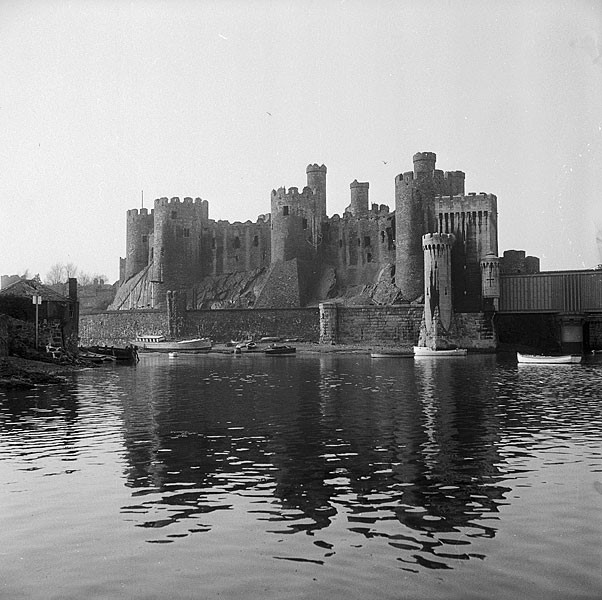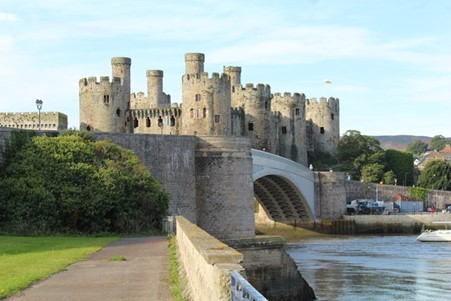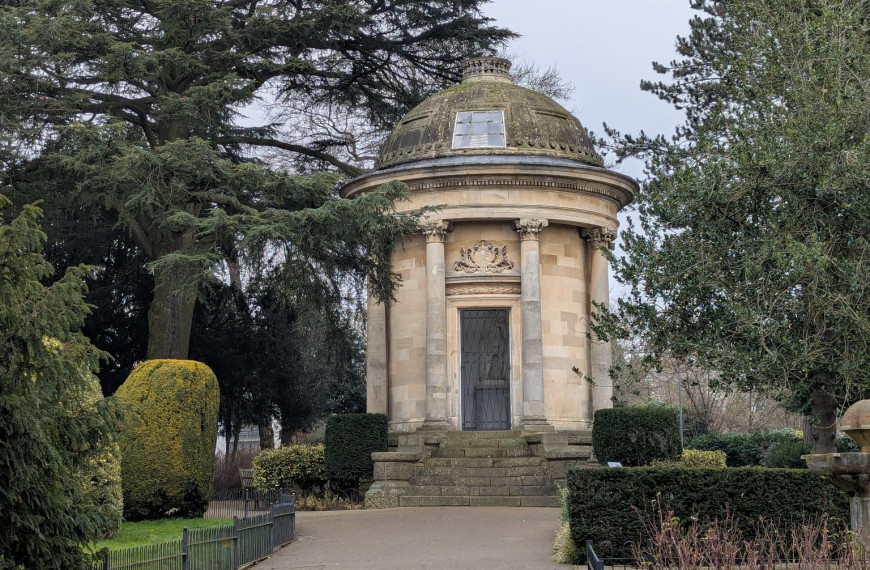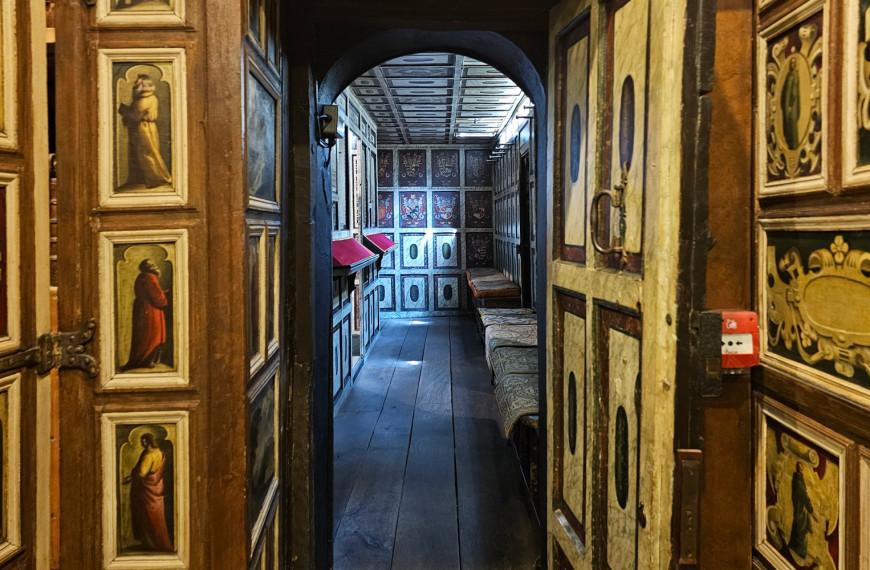In the second of our series of articles about the AMS Transactions, we look back on the Society’s early casework. Volume 1, published in 1953, reported on the AMS’s efforts to stop a road being driven through the medieval heart of Conwy.
This article will tell the story of the beautiful Welsh town of Conwy and the Ancient Monuments Society’s efforts to protect its historic buildings from damage in a rapid time of development. The tale is made all the more interesting by the involvement of John Swarbrick, who founded the AMS in 1924.

Photo: Geoff Charles, Conway Casttle, CC0 (Wikimedia Commons)
Why was the AMS concerned about Conwy?
Conwy is home to a medieval castle and town walls, two industrial bridges and many historic buildings. It is its built heritage that makes Conwy so special.
In the mid-1930s, the Ministry of Transport proposed a new road to connect Chester and Bangor. It could either pass straight through Conwy, or be directed around it by a by-pass. The AMS got involved to ensure any new developments did not harm Conwy’s historic buildings.
A 1973 volume of the Transactions, which explores the early history of the AMS, cites letters that were exchanged between the society, the Minister of Transport Leslie Hore-Belisha, and former Prime Minister David Lloyd George in 1936. In them, the AMS advocates the construction of a bypass to carry traffic around Conwy rather than directly through it. ‘The only thing that can be done satisfactorily with Conway’, the AMS writes, ‘is to treat it as a Museum piece and to keep all modern development entirely outside the city walls.’ The AMS adds, ‘we would deplore anything that would mean the ultimate destruction of such a perfect example of medieval town life.’[1]
In response to the AMS’s letter, Lloyd George made a special visit to Conwy and raised the issue of the Chester-Bangor road in the House of Commons. Encouraged by Hore-Belisha, the AMS also got in touch with the Ministry’s Divisional Road Engineer for Wales, Sam Evans, and the society and Evans organised to meet at Caer Rhun Hall in Conwy Valley on 2nd June 1936. The conference ended with both parties agreeing that the best course of action would be to carry the road outside Conwy town walls.
A Public Inquiry was then held at Conwy on July 2th and 7th-8th in 1939 to discuss the route of the proposed by-pass. While some endorsed the plan to build a road through the town, the majority of those who attended were in favour of directing it along the quay outside the town walls and by the coast. This proposal was supported by the AMS and the Society of Antiquaries, which was represented at the inquiry by archeologist Sir Cyril Fox.
At the investigation, the AMS said that carrying traffic through Conwy ‘would not only destroy the sense of scale, which is essential if the charm of the town is to be maintained, [but] it would also have the effect of […] breaking it up in such a way as to make it possible for visitors to rush through it without understanding […] what it was originally like.’ Additionally, the ‘noise and rush of traffic […] would fatally destroy the quiet that makes it possible to […] study the ancient town.’[2]
The Minister of Transport accepted the AMS’s view and made the Conwy By-Pass Order on 17th May 1940. At the start of World War II, it seemed certain that a by-pass would be constructed outside Conwy town, ensuring the protection of its historic buildings and structures.
What has happened to Conwy since?
The Conwy by-pass proposal was neglected during World War II, but it was revived in the early 1950s. Unfortunately, when it came up for discussion again, the plan to thread a road directly through Conwy town was approved. In 1958, a new bridge was built over the river, parallel to those constructed by Stephenson and Telford in the 19th century. To reach this bridge, traffic had to pass directly through Conwy town.

Conwy castle and the A547 road bridge built in 1958 Photo © Richard Hoare (cc-by-sa/2.0)
In the following decades the traffic became notoriously bad. A constant stream of cars and lorries was directed under low arches and along narrow one-way streets. As the AMS feared, this effectively destroyed the ‘charm’ and ‘quiet’ of Conwy.
By the 1990s, traffic had become so bad that it could no longer be ignored.[3] It was proposed that a new bridge be built across the river to improve the congestion. The plan was rejected, however, on the grounds that it would ruin the view of the medieval castle and 19th-century bridges. Instead, an immersed tube tunnel bypass was constructed just north of Conwy. This directed the road away from the town and under the River Conwy.
While the AMS would no doubt have been devastated by the fact that a main road was carried through the town, there were other developments in the 1950s and later that would have pleased them. In 1953, the town council of Conwy agreed to lease the castle and town walls to the state for 99 years. This means that in this period the government was, and continues to be, responsible for their maintenance and any restoration work. Today, Cadw cares for the castle and town walls, on behalf of the Welsh Assembly Government.
Conwy castle and town have been made Grade I listed buildings and part of a World Heritage Site of ‘Castles and Town Walls of King Edward in Gwynedd.’ This is in addition to their status as scheduled ancient monuments. The construction of the tunnel bypass in the 1990s was the first instance where a significant amount of money was invested in infrastructure to protect a World Heritage Site.[4] This was a major achievement in the field of building conservation.
Conwy is now in the safe hands of Cadw and Conwy town council. Huw Davies informs me that it still encounters difficulties in trying to accommodate tourism within a medieval walled town, but that everything is carefully managed to ensure the protection of Conwy’s historic structures.[5]
Reflections on the AMS’s work at Conwy
In the first volume of the Transactions, the AMS made clear its aim was not only to study but to actively conserve historic buildings, structures and sites. It is believed that Conwy is the first important piece of casework the AMS were involved in.
With its collection of different buildings—medieval walls and castle, 16th-19th century town houses and public buildings—Conwy was the perfect early case for the AMS because it reinforced its declaration that they would actively protect historic buildings of all periods and types.
In Conwy, the society won some battles and lost others. While not a straightforward success story, Conwy shows how tirelessly the AMS were, and are, prepared to fight for the future of historic buildings.
Swarbrick’s reflections on Conwy in the Transactions provide a good conclusion and also encapsulate the approach of the AMS. ‘[T]his precious relic of the past’, he writes, ‘does not merely belong to the present generation alone. We are tenants for life, but also trustees, called upon to preserve out heritage for the benefit of those who follow us.’
Coco Whittaker
Coco Whittaker is a recent graduate of the University of Cambridge, where she studied History of Art and Architecture. She specialised in architectural history and wrote her dissertation on 16th and 17th century church pews in Shropshire. Coco will be returning to Cambridge in October to study on the part-time MSt in Building History. She has a keen interest in historic buildings and structures and their conservation.
Further Reading
Transactions of the Ancient Monuments Society, Vol. 1, (Clifford’s Inn, London: The Ancient Monuments Society, 1953)
Transactions of the Ancient Monuments Society, Vol. 20, (Clifford’s Inn, London: The Ancient Monuments Society, 1973)
‘Timeline of Conservation Catalysts and Legislation: A history of listing since 1560’ on Historic England website, https://historicengland.org.uk/whats-new/features/conservation-listing-timeline/
Cadw, ‘World Heritage Site Management Plan 2018-28: Castles and Town Walls of King Edward in Gwynedd World Heritage Site’, https://spp.conwy.gov.uk/upload/public/attachments/692/LDP42_The_Castles_and_Town_Walls_of_King_Edward_in_Gwynedd_Management_and_Action_Plan.pdf
[1] The letters from the AMS were written by Swarbrick and Angus-Butterworth.
[2] The AMS were represented at the public inquiry in 1939 by Kendrick and Swarbrick.
[3] Plans for an alternative road began in the 1960s and the tunnel was chosen as the best crossing option in the 1980s
[4] The Conwy immersed tube tunnel bypass cost a total of £144m.
[5] Conwy’s buildings are well cared for by Conwy council and Cadw. In recent decades, the council has created a Conservation Area Management Plan (2007-2022) and has collaborated with Cadw to publish a World Heritage Site Management Plan. Huw Davies, Senior Conservation Officer in Conwy, also informs me that Conwy castle was the most visited Cadw site in Wales last year (2018) and they hope to see an increase in visitors following the opening of a new Culture Centre, which is being built to the west of the town. This will educate the public on the historic value of Conwy town.


